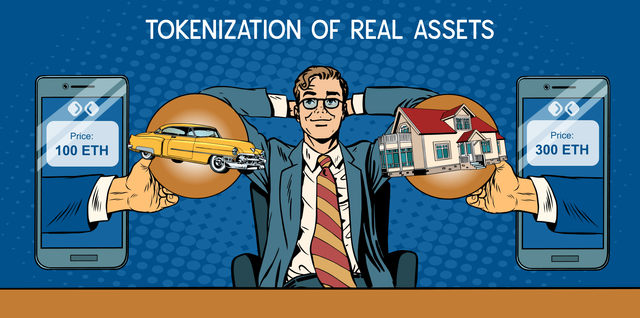Tokenization of real assets
🤗Welcome to our community!
In previous articles, we told you about our first product, the decentralized Barter wallet. If for some reason you missed them, we recommend you to get acquainted with our first mobile decentralized wallet in this series of articles “What we create: Part 1, Part 2, Part 3” or a document that we specially prepared for our future plans.
Continuing speaking on the topic of decentralized finance, we want to tell you about the tokenization of real valuable assets, and what advantages it provides in some cases of using.
Perhaps, in a few years, paper workflow will acquire the same status as a push-button telephone in the world of mobile devices. Digitalization is rapidly capturing not only the financial world, but also all other areas of activity that today require optimization of the most private processes.
Why did we touch on the topic of workflow? Speaking about the tokenization of real valuable assets, we need to understand why this should be done and how to use it in the real world.
Let’s start from the very beginning.
When creating a digital copy of an object, we must understand what specific unique properties it has, allowing it to be distinguished from other objects of the same type, and how appropriate it is to do so. Different types of objects can have completely different properties, according to which they can be characterized. These unique features are recorded when creating a virtual copy of the object (tokenization), including information about the owner, in order to establish ownership.
Why is it useful to tokenize real objects?
Firstly, tokenization “connects” to Web 3.0, and therefore to all the features of the Ethereum blockchain. Today, Ethereum is the most developed ecosystem for decentralized applications of varying complexity.
Secondly, speaking about the possibilities of Ethereum smart contracts, tokenization will optimize, and in some cases completely automate processes.
When entering into transactions, real-world objects are physically moved; or the ownership of the asset is changed; or these objects are moved with changing the ownership.
At the beginning of the article, we mentioned the document flow for some reasons — because any transaction is accompanied by a legal contract, which is a legal right to own and dispose of a real object. Many experienced lawyers know how the process of filling out the documents that accompany the transaction is long; moreover, the contracts are not written on paper in a single copy. The second difficulty is the safety of such documents. With the advent of computers, documents began to acquire a mandatory electronic copy (scanning of an official paper document) for the convenience and safety of storage. The electronic database accelerates the search for the desired document or any requested information up to the moment. So, we can assume that the second area that requires optimization is jurisprudence.
We, Barter team members, believe that smart contracts can and should be applied in the legal field, where an electronic document is a legal source and a paper copy will be created “just in case” or for quick access.
By concluding a legal digital smart contract in trade relations, the parties to the contract can do this remotely from each other if all the conditions are provided for this. Ultimately, participants must be sure that each of them will receive the property that was specified in the contract. As we said earlier, each object has a set of unique qualities that allow it to be characterized, and, therefore, to establish that the token belongs to a real object. For legality, we must have a trusted place for processing and storing information received in the process of concluding a contract. When we talk about a decentralized economy, one way or another, we allude to the blockchain. Speaking about the reliability of the blockchain, we mean trust in the main servers, nodes, due to which the distributed network works.
Barter seeks to create a digital contract execution environment where a smart contract would be legally binding if such a contract was concluded on paper in the presence of a notary public with his stamp.
Having such a trusted legal digital environment, we can automate trade relations through tokenization of trade objects. As we said earlier, tokenization connects the object to the capabilities of Web3, and therefore to our “legal” blockchain.
Having a token of a real object, it can be placed on a marketplace, for example, on a smartplace in a decentralized Barter wallet, to take advantage of the possibilities of legal automated exchange. Smartplace will support multiple trading protocols, such as auction and barter trading.
In the next article, we will tell you about the possibilities of auctions and barter trading and in which cases these protocols are very convenient to apply.
Decentralized finance has really come a long way, but it is very difficult for a tech-savvy user who does not know English.
The Barter team aims to attract a mass user to the world of cryptocurrency and decentralized finance by providing a convenient and simple interface to a decentralized application.
We are already completing the prototyping phase and will soon show you our application, follow us on Twitter and ask questions in Telegram.
🤩Have a nice day!🤩
Recall that now the project is at the stage of pre-sale of tokens, the proceeds from the sale of which are invested in the development of the Barter project
We accept ETH and BTC to official wallets:
Ethereum — 0x17d3d1da06688bc61592913921414bff09bc570c;
Bitcoin — 17BexJeUQfM1iQqtgoAaqgBLPdRvKZUTR1.
BRTR tokens will be credited to each participant when the wallet is launched.
